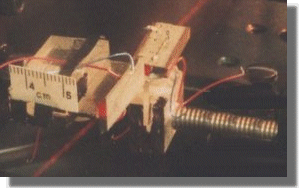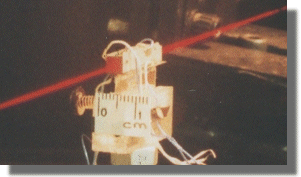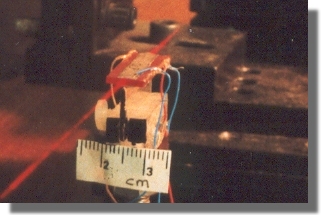
2-D LASER SCANNERS
|
Home Beam stabilization in FSOC Optical Switching 2-D laser scanning CONTACT US |
FEATURES
| Two deflectors in series at right angles Single substrate 
|
SeaLite Engineering has developed a solid state optical beam refractor capable of optically scanning a laser beam at rates of 10 KHz with a time response of 3 microseconds. By combining two deflectors in series and at right angles, an X-Y scanner is achieved which is capable of scanning images in two dimensions at frame rates of up to 300 frames per second; currently used mechanical scanners are limited to 10 frames per second. The Stress-OpticTM components are available as single elements that can be incorporated into line scanners, or as dual elements for X-Y scanners. The present single-element specifications are given below. Also, both dimensions can be combined on a single substrate as shown here.
Operation
The optical beam refractors make use of the Stress-OpticTM principle for refracting light passing through an optical glass substrate*.The glass substrate generally measures 25 x 10 x 2 mm. Thin films are attached to the two 25 x 10 mm glass sides and accept an electric voltage.
The electric field that results produces stress within the glass, which then refracts a laser beam traveling inside the glass along the 25 mm dimension. The angle of deflection is directly proportional to this applied voltage.
The films are driven by a high voltage, high frequency amplifier, which is fed by a 12 bit Digital to Analog converter. The resulting unit can be calibrated to produce a predictable angel of deflection to an accuracy of at least 1 microradian as a function of the 12 bit digital input. The 12 bit digital interface is suitable for a variety of microprocessor designs that can drive the laser beam under software control.
Potential Applications
Applications for the Stress-Optics refractors are in the design of high-speed laser scanners, optical integrated circuits and telecommunications. Currently, laser scanners are built using rotating or oscillating mirrors.
These designs are limited to frequencies of less than 300 Hz. Since Stress Optics is free of bulk mechanical components, frequencies of 10KHz and higher are attainable.
ONE DIMENSION STRESS-OPTIC REFRACTOR
| |
| SPECIFICATIONS | |
| Physical | |
| Optical Path Lenth: 25 to 75 mm | Width: 3 to 12mm |
| Thickness: 1 to 3 and 15 mm | Substrate Material: Optical Glass |
| Electrical | |
| Electrode Voltage: 160/-80 Volts | Power: Capacitive; 1mW Dissapative; 3 µW |
| Optical | |
| Beam Diameter: 0.5 to 2 mm | Wavelenth: 500 to 1200 nm |
| Polarization: Linear and Random | Optical Power Throughput: > 100 Watts |
| Optial Excess Loss: < 1db | Time Response, Step voltage: 3 µsec |
| Max Frequency: Up to 100KHz | Pointing Repeatability: < 1 µRadians |
| Scan Resolution: 70 diameters | Temp. Dependence: Undetectable |
| Deflection Angle: 0.7 to 6 Degrees; with lensing: up to 21 Degrees | |
| Vibration Sensitivity: Low; Free-Wave,Gradient Steering | |
Availability: in the immediate future 2-D laser scanners are available as a custom-made system or as part of Beam Stabilization in FSOC. Contact us on your application.
*U.S. patents 5,095,515, 5,383,048 and 6,034,811
